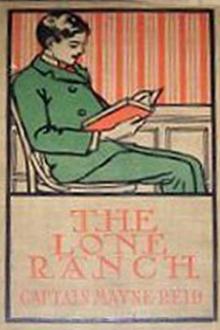The Boy Hunters, Mayne Reid [best love novels of all time .TXT] 📗

- Author: Mayne Reid
Book online «The Boy Hunters, Mayne Reid [best love novels of all time .TXT] 📗». Author Mayne Reid
There are eight marrow-bones in the buffalo, containing several pounds of this substance. As Basil had heard from the old hunters, it is esteemed the most delicious part of the animal; and is rarely left behind when a buffalo has been killed. The best method of preparing it is by simply roasting it in the bone; although the Indians and trappers often eat it raw. The stomachs of our young hunters were not strong enough for this; and a couple of the shank-bones were thrown into the fire, and covered over with red cinders.
In due time the marrow was supposed to be sufficiently baked; and the bones having been cracked by Lucien’s hatchet, yielded up their savoury store—which all three ate with a great relish. A cup of cool water washed it down; and around the camp-fire of the boy hunters thirst and hunger were now contemplated only as things of the past. Jeanette was respited, without one dissentient voice.
Our adventurers were surrounded once more with the cheerful atmosphere of hope. There was still enough of marrow in the remaining bones to last them for two days at the least; for this marrow is a most nourishing food. Moreover, by following the buffalo-trail, they would be likely to fall in with other skeletons of these animals; and all apprehensions on the score of food now vanished from their minds. Another fact, which the skeleton of the buffalo revealed to them, added to their joyful anticipations. They had observed on first going up to it—that the bones were still fresh! The wolves had not been long gone from it. It could not have been a long time killed. All this showed, that the buffaloes themselves had but very recently passed over the ground, and could not be far distant. These were cheering thoughts; and for a while the young hunters sat around the sage-fire, revolving them in their minds, and conversing upon them. Then, having offered thanks to that Being who had so many times miraculously preserved them, they rolled themselves in their blankets, and, notwithstanding a heavy shower of rain that fell, once more found the solace of a good night’s sleep.
Next morning the boy hunters were up and stirring at the “peep of day.” They felt refreshed and cheerful. So did their animals, for the grass was good. Jeanette was frisking about on her trail-rope and endeavouring to reach “Le Chat,” whom she would have kicked and bitten to a certainty, but that the lasso-tether restrained her. Jeanette little dreamt how near she had been to her last kick. Had she known that, it is probable she would have carried herself with more sobriety, not knowing but that a similar necessity might occur again. But Jeanette knew nothing of it; and, having eaten well and drunk plentifully, she was as frisky as a kitten.
A fire was kindled, and a fresh “marrow-bone” steamed and sputtered among the blazing branches of the sage. This was soon drawn forth again, cracked, and its rich contents rifled and eaten. The remaining joints were packed upon Jeanette; the horses were saddled, the hunters leaped into their seats, and rode joyfully off upon the trail.
The country over which they now travelled was what is termed a “rolling prairie”—that is, a country without trees, but nevertheless, far from being level. The prairie is not always a level plain, as some people imagine. On the contrary, it is often of very uneven surface, containing high hills and deep valleys. The word “prairie” means properly an open level country, though it is not necessary that it should be a dead horizontal level, to entitle it to the name. It may contain hills, valleys, and long ridges. It is not necessary either that it should be entirely destitute of trees; for there are the “timber prairies,” where trees grow in “mottes” or groves, sometimes termed islands—from their resemblance to wooded islands in the sea. The “prairie” is a term used to distinguish those vast meadow-like tracts of the earth’s surface from the forest, the mountain, and the ocean. The prairies themselves are distinguished by specific names, according to what covers their surface. We have seen that there are “timber prairies” and “flower-prairies.” The latter are usually denominated “weed prairies” by the rude hunters who roam over them. The vast green meadows covered with “buffalo” grass, or “gramma,” or “mezquite” grass, are termed “grass prairies.” The tracts of salt efflorescence—often fifty miles long and nearly as wide—are called “salt prairies;” and a somewhat similar land, where soda covers the surface, are named “soda prairies.” There are vast desert plains where no vegetation appears, save the wild sage-bushes (artemisia). These are the “sage prairies,” hundreds of miles of which exist in the central parts of the North American continent. There are prairies of sand, and “rock prairies,” where the “cut-rock” and pebble deposits cover the arid plains; and still another variety, called the “hog-wallow prairies,” where the surface for miles exhibits a rough appearance, as if it had been at some remote period turned over or “rooted” by hogs.
Most of these names have been given by the trappers—the true pioneers of this wild region. Who have an equal right to bestow them? Scientific men may explore it—topographical officers may travel over it in safety with a troop at their heels—they may proclaim themselves the discoverers of the passes and the plains, the mountains and the rivers, the fauna and the flora—on their maps they may give them the names, first of themselves, then of their patrons, then of their friends, and, lastly, of their favourite dogs and horses. They may call stupendous mountains and grand rivers by the names of Smith and Jones, of Fremont and Stansbury; but men who think justly, and even the rude but wronged trappers themselves, will laugh to scorn such scientific coxcombry.
I honour the names which the trappers have given to the features of that far land; many of which, like the Indian nomenclature, are the expressions of nature itself; and not a few of them have been baptised by the blood of these brave pioneers.
We have said that our adventurers now travelled upon a “rolling prairie.” The surface exhibited vast ridges with hollows between. Did you ever see the ocean after a storm? Do you know what a “ground-swell” is?—when the sea is heaving up in great smooth ridges without crest or foam, and deep troughs between—when the tempest has ceased to howl and the winds to blow, yet still so uneven remains the surface of the mighty deep, still so dangerous are these smooth waves, that ships rock and tumble about, and sometimes lose their masts, or are flung upon their beam ends! That is what the sailors call a “swell.” Now, if you could imagine one of these billowy seas to be suddenly arrested in its motion, and the water transformed to solid earth, and covered with a green sward, you would have something not unlike a “rolling prairie.” Some think that, when these prairies were formed, some such rolling motion actually existed, by means of an earthquake, and that all at once the ground ceased its undulations, and stood still! It is an interesting speculation for the learned geologist.
The ridges of the prairie, upon which our adventurers were journeying, extended from east to west, and, of course, the valleys trended in the same direction. The route was northward; the path, therefore, which the travellers pursued was a continued succession of ups and downs.
Eagerly looking before them, anxiously scanning the valleys or troughs of the prairie as they surmounted each new swell, they rode onward full of hope that they would soon come in sight of the buffaloes. But they were not prepared for the sight was so soon to greet their eyes—a sight which one would have supposed would have filled them with joy, but which, on the contrary, had the effect of inspiring them with a feeling akin to terror.
They had just climbed one of the ridges that gave them a view of the valley beyond. It was a small deep valley, of nearly a circular form, and covered with a green turf. Near one side of it was a spring—the waters of which issuing forth ran nearly around the circumference of the valley, and then escaped through one of the troughs of the prairie. The course of this rivulet could be traced by the low trees—cotton-woods and willows—that fringed its banks; so that the central part of the valley presented the appearance of a small circular meadow almost surrounded by a grove.
It was in this meadow that a spectacle was offered to the eyes of our adventurers, which caused them to rein suddenly up, and sit gazing down upon it with singular emotions. The spectacle was that of a number of animals engaged in what appeared to be a mixed and terrible combat! There was not over a dozen of them in all, but they were large animals, of fierce aspect and furious bearing; and so desperately were they assailing one another, that the green turf around them was torn and furrowed by their hoofs. It was in the middle of the meadow that this indiscriminate contest was carried on—in the open ground—and a finer spot for such an exhibition they could hardly have chosen, had they wished to accommodate a large number of spectators. The valley itself, with the ridges that encircled it, was not unlike one of the great Spanish amphitheatres, where bull-fights are carried on; while the smooth, level surface of the meadow represented the arena. The combatants, however, were engaged in no mock encounter to gratify the curiosity of an idle crowd; nor did they apprehend that there were spectators present.
The contest in which they were engaged was a real fight; and their angry roars, their hurried rushing backwards and forwards, and the loud cracking of their skulls as they came together, proved them to be in earnest.
That the animals were buffaloes was apparent at first sight. Their great bulk, the lion-like form of their bodies, but, above all, their bellowing, that resembled the “routing” of enraged bulls, convinced our young hunters that they could be no other than buffaloes—and buffaloes they were—a “gang” of old buffalo bulls engaged in one of their terrible tournaments.
I have said that our hunters, on first seeing them, were influenced by feelings of terror. But why so? What was there in the appearance of a herd of buffaloes to frighten them, since that was the very thing they had so long been in search of? Was it the angry attitudes of the animals, or their loud roaring? Nothing of the sort? No. That was not what had inspired them with fear, or, as I should rather term it, with awe. No. The reason was very different indeed. It was not because they were buffaloes, or because they were engaged in a fierce battle,—it was because they were white buffaloes!
You will again ask, why this should have been a cause of terror. Was a white buffalo not the very object of the expedition? Should the sight of one not have produced joy rather than fear? So the sight of one would; but it was the sight of so many—the mysterious spectacle of nearly a dozen of these animals together—a thing unparalleled, unheard of—it was this that inspired our adventurers with awe.
It was some time before any of the three could find words to express their astonishment. They sat in silence, gazing down into the valley. They could hardly believe the evidence of their eyes. With the palms of their hands they shaded them from the sun, and gazed still a longer while.





Comments (0)